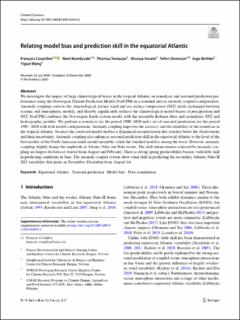| dc.contributor.author | Counillon, Francois | |
| dc.contributor.author | Keenlyside, Noel | |
| dc.contributor.author | Toniazzo, Thomas | |
| dc.contributor.author | Koseki, Shunya | |
| dc.contributor.author | Demissie, Teferi Dejene | |
| dc.contributor.author | Bethke, Ingo | |
| dc.contributor.author | Wang, Yiguo | |
| dc.date.accessioned | 2021-06-02T11:24:03Z | |
| dc.date.available | 2021-06-02T11:24:03Z | |
| dc.date.created | 2021-01-23T18:34:21Z | |
| dc.date.issued | 2021 | |
| dc.identifier.issn | 0930-7575 | |
| dc.identifier.uri | https://hdl.handle.net/11250/2757387 | |
| dc.description.abstract | We investigate the impact of large climatological biases in the tropical Atlantic on reanalysis and seasonal prediction performance using the Norwegian Climate Prediction Model (NorCPM) in a standard and an anomaly coupled configuration. Anomaly coupling corrects the climatological surface wind and sea surface temperature (SST) fields exchanged between oceanic and atmospheric models, and thereby significantly reduces the climatological model biases of precipitation and SST. NorCPM combines the Norwegian Earth system model with the ensemble Kalman filter and assimilates SST and hydrographic profiles. We perform a reanalysis for the period 1980–2010 and a set of seasonal predictions for the period 1985–2010 with both model configurations. Anomaly coupling improves the accuracy and the reliability of the reanalysis in the tropical Atlantic, because the corrected model enables a dynamical reconstruction that satisfies better the observations and their uncertainty. Anomaly coupling also enhances seasonal prediction skill in the equatorial Atlantic to the level of the best models of the North American multi-model ensemble, while the standard model is among the worst. However, anomaly coupling slightly damps the amplitude of Atlantic Niño and Niña events. The skill enhancements achieved by anomaly coupling are largest for forecast started from August and February. There is strong spring predictability barrier, with little skill in predicting conditions in June. The anomaly coupled system show some skill in predicting the secondary Atlantic Niño-II SST variability that peaks in November–December from August 1st. | en_US |
| dc.language.iso | eng | en_US |
| dc.publisher | Springer | en_US |
| dc.rights | Navngivelse 4.0 Internasjonal | * |
| dc.rights.uri | http://creativecommons.org/licenses/by/4.0/deed.no | * |
| dc.title | Relating model bias and prediction skill in the equatorial Atlantic | en_US |
| dc.type | Journal article | en_US |
| dc.type | Peer reviewed | en_US |
| dc.description.version | publishedVersion | en_US |
| dc.rights.holder | Copyright 2021 The Authors | en_US |
| dc.source.articlenumber | 2617–2630 | en_US |
| cristin.ispublished | true | |
| cristin.fulltext | original | |
| cristin.qualitycode | 1 | |
| dc.identifier.doi | https://doi.org/10.1007/s00382-020-05605-8 | |
| dc.identifier.cristin | 1877670 | |
| dc.source.journal | Climate Dynamics | en_US |
| dc.identifier.citation | Climate Dynamics. 2021, 56, 2617–2630 | en_US |
| dc.source.volume | 56 | en_US |

